Juul E-Cigarettes
Juul is the most widely used electronic cigarette in the United States. But many of its users are unaware that all Juul pods contain nicotine. And Juul pods deliver some of the largest and most powerful nicotine doses among all e-cigarettes. This leaves users open to addiction risks and several serious health dangers.
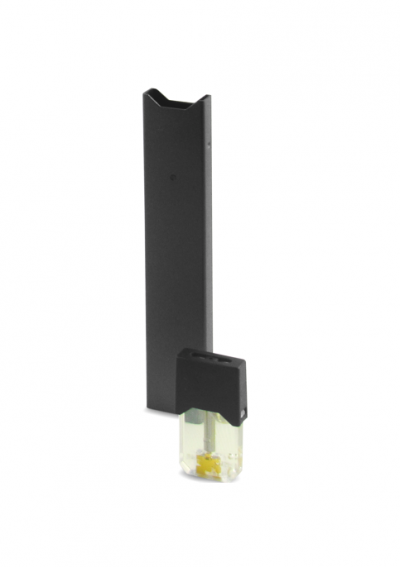
What Are Juul E-Cigarettes?
Juul e-cigarettes heat and vaporize liquids for users to inhale. Juuls hit the market with more than twice the nicotine content of other e-cigarettes at the time and are some of the most popular vaping products on the market. In June 2022, the U.S. Food and Drug Administration issued marketing denial orders, or MDOs, effectively banning Juul from the market. After Juul filed an emergency appeal, the FDA issued a temporary stay on the MDO in July 2022 until it could review additional data. In September 2022, Juul sued the FDA for failing to produce scientific data used to ban the company’s vaping products.
The company faces lawsuits alleging its design and early marketing was targeted adolescent consumers. Lawsuits also involve product defects and allegations of injuries.
A California judge approved Juul’s preliminary offer of $255 million to settle a class action lawsuit over economic loss claims in January 2023. Plaintiffs in the class said they would have paid less, or not bought e-cigarettes, if Juul had not misrepresented the product. The settlement is part of a larger agreement by Juul to address thousands of lawsuits filed by individuals, school districts and local governments. In March 2023, Juul entered into a $23.8 million settlement agreement with the city of Chicago over claims that it deceptively marketed its products and sold vapes to minors.
How Does Juul Work?
Juul has been called “the iPhone of e-cigarettes,” and its branding and packaging are similar to Apple’s signature minimal style. When it premiered in 2015, Juul incorporated innovations in aesthetic design, electronics and chemistry that were big departures from earlier e-cigarettes.
Juul has a sleek, lightweight design meant to mimic the weight and feel of a tobacco cigarette. The gadgets look like flash drives and can be recharged by plugging them into a computer’s USB port. The battery powers a heating element that vaporizes liquid contained in an interchangeable pod.
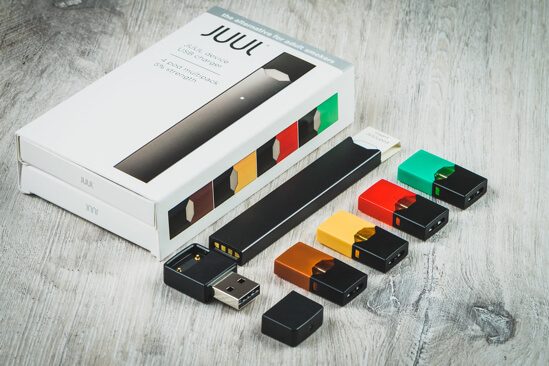
Juul pods come in several flavors but all contain nicotine salts. By mixing benzoic acid with nicotine salts, Juul’s inventors were able to deliver nicotine to the brain as fast as tobacco cigarettes. This was something no other e-cigarette could do at the time.
The pod serves as the mouthpiece after it’s connected to the Juul stick. There are no on-off switches or other settings. The Juul device detects when you inhale and automatically heats the liquid into a vapor. Once you stop inhaling vapor, the Juul goes into standby until your next puff.
Aggressive Marketing Propelled Juul’s Popularity
Juul more than tripled its share of the United States e-cigarette market in just 15 months. In August 2017, Juul accounted for 24% of the market. By October 2018, it sold 75% of the e-cigarettes in America.
Studies suggest that the explosive growth was due to an aggressive social media marketing strategy that attracted teens and young adults to the product. Juul Labs says its products are meant to be used by adults to help them stop smoking, and its current ads reflect that. But a 2019 study by Stanford researchers found the first six months of Juul marketing targeted young people, not adult smokers.
In September 2022, Juul agreed to pay close to $440 million to resolve allegations brought up by 33 states that the company’s marketing tactics targeted teens. The allegations arose from a 2-year investigation into Juul’s marketing practices.
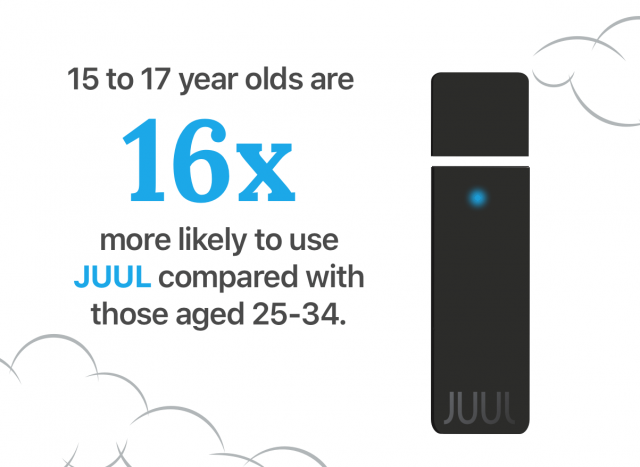
Stanford Research Into the Impact of Tobacco Advertising, a repository of tobacco advertisements and research, notes that early Juul marketing efforts involved recruiting “youthful influencers” to popularize the e-cigarettes on social media. Juul paid these high-profile social media stars to write favorable reviews but to keep financial arrangements off the radar.
Juul Use Among Teens and Young Adults
Juul and other e-cigarettes are not supposed to be sold to anyone under the age of 18. But the devices have become extremely popular among people far younger than that.
A 2019 report from the anti-smoking advocacy group Truth Initiative found that 15- to 17-year-olds were 16 times more likely to try Juul than 25- to 34-year-olds. And more than half of users were younger than 18 the first time they used Juul.
It’s easy for a teen to conceal a Juul e-cigarette from parents and teachers. Adults often mistake them for flash drives, and they are small enough for a teen to hide the device in the palm of their hand.
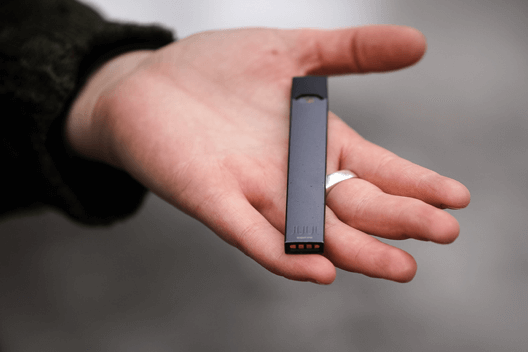
The United States Surgeon General’s Office estimates that 1 in 5 high school students used an e-cigarette in 2018. But the number may be higher due to a language gap. Researchers have found that teens don’t often realize Juul is an e-cigarette and may not accurately answer survey questions about using the product.
Public health researchers found teens frequently use the term “Juuling” instead of “vaping” and believe the two to be distinct activities. The confusion was pronounced enough that researchers changed the language in 2019’s National Youth Tobacco Survey to better track Juul use among teens. The survey is conducted each spring by the Centers for Disease Control and Prevention and the FDA.
Juul Addiction Risks
While Juul’s design intrigues potential users, it is the product’s nicotine that keeps customers coming back. Nicotine is highly addictive, and Juul Labs has claimed its device delivers nicotine up to 2.7 times faster than competitors.
Each pod contains about as much nicotine as a pack of 20 tobacco cigarettes. That was twice the nicotine as most other e-cigs when Juul first hit the market. Other brands have since engaged in what a 2019 British Medical Journal study called a “nicotine arms race” to increase the amount of nicotine in their products in an effort to keep up with Juul.
Nicotine increases the levels of the neurotransmitter dopamine in the brain, which activates reward pathways. It promotes a feeling of pleasure. But the reward is short-lived, which leads to the desire to seek more nicotine.
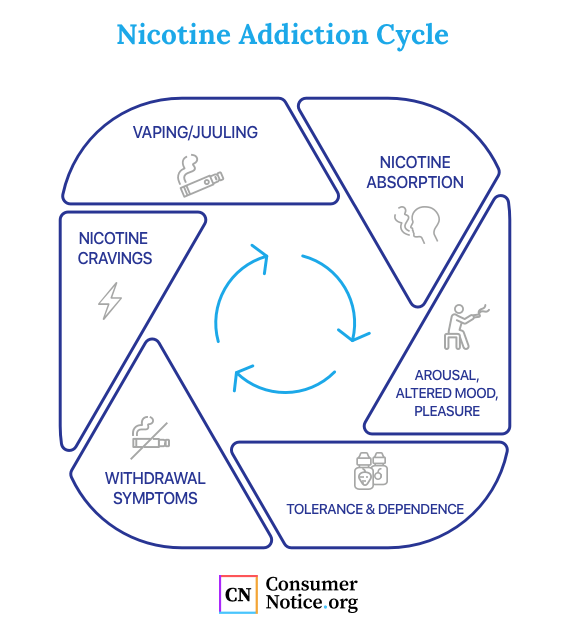
A 2018 study of youth and young adults in the journal Tobacco Control found that 63% of Juul users did not know the product contained nicotine.
A 2017 study at the University of Southern California found that teens who vaped higher doses of nicotine — such as those found in Juul pods — were more likely to become regular smokers. Researchers found that 43% of high school students who used high-nicotine e-cigarettes such as Juul at the start of the study were “frequent smokers” six months later. The researchers published their work in JAMA Pediatrics.
Parents and teachers can play a major role in reducing teen nicotine addiction. It can be as simple as knowing the facts about students and vaping, and explaining the dangers in a frank and reasonable discussion.
Side Effects of Juul and Nicotine
Both nicotine and the flavorings used in Juul pods have been associated with serious and permanent health conditions. Nicotine’s effects have been known for decades but because e-cigarettes are a relatively new invention, researchers are still learning about health risks from Juul and other e-cigarettes.
Nicotine Side Effects
Nicotine is poisonous. Outside of smoking and vaping, its only other known use has been as an insecticide. It’s been sprayed on crops to kill bugs since the 17th century. The United States Environmental Protection Agency banned its use as an insecticide in 2014.
Nicotine poisoning in people depends on several factors, including body weight and how much nicotine you have in your system.
At least eight research studies since 1995 have found nicotine has the potential to cause cancer. It’s also known to cause complications for the heart, lungs, kidneys and reproductive system.
Nicotine can stunt brain development in teens and young adults. The human brain doesn’t stop developing until a person is about 25 years old. Nicotine use before then can prevent the prefrontal cortex from fully developing. That’s the part of the brain that handles decision making, impulse control and other higher personality functions.
Nicotine use in adolescence has also been associated with behavioral problems later in life, including substance abuse and mental health problems. Nicotine can cause long-term problems with learning, memory and the ability to pay attention.
Heart Damage from Juul and Other E-Cig Flavors
A May 2019 study from Stanford School of Medicine found the flavors used in e-cigarettes such as Juul damaged blood vessel cells grown in a lab. The damage resulted even if there was no nicotine mixed with the flavors. The amount of damage varied between flavors but was most severe with cinnamon and menthol.
The flavors damaged endothelial cells that line the insides of blood vessels. Damage to these cells leads to other cardiovascular diseases. The researchers published their work in the Journal of the American College of Cardiology.
Researchers conducted the study on tissue in a lab and later research on humans may not produce the same results. But it shows how researchers are just beginning to look at how Juul and other e-cigarette products may cause harm.
Injuries Claimed in Juul Lawsuits
Juul lawsuits claimed that Juul can cause serious health problems such as chest congestion, severe breathing difficulties, lung damage and seizures. In April 2019, the FDA announced it was investigating reports of seizures after e-cigarette use. The agency identified 35 cases reported since 2010 and most involved teens and young adults. It said there was a “slight but noticeable” uptick in reports starting in 2018, the same year Juul saw sevenfold growth, according to The Washington Post.
In addition to these side effects, plaintiffs said Juul vaporizers can catch fire or explode, injuring users. Lawsuits also accused the e-cigarette maker of marketing to children and teens, causing them to become addicted to Juul. Lawyers are accepting Juul addiction lawsuits from people who used Juul before they turned 18 and became addicted or suffered seizures and other problems. Parents and guardians can file lawsuits on behalf of affected children or teens.
37 Cited Research Articles
Consumernotice.org adheres to the highest ethical standards for content production and references only credible sources of information, including government reports, interviews with experts, highly regarded nonprofit organizations, peer-reviewed journals, court records and academic organizations. You can learn more about our dedication to relevance, accuracy and transparency by reading our editorial policy.
- Rajesh, A.M. (2023, March 10). Juul reaches settlement with Chicago for nearly $24 mln. Retrieved from https://www.reuters.com/legal/juul-reaches-settlement-with-chicago-nearly-24-mln-2023-03-10/
- Reuters. (2023, January 23). U.S. judge grants preliminary approval to Juul consumer settlement. Retrieved from https://www.reuters.com/business/healthcare-pharmaceuticals/juul-settlement-end-youth-vaping-lawsuits-wins-preliminary-approval-bloomberg-2023-01-20/
- Jewett, C. (2022, September 6). Juul Settles Multi-State Youth Vaping Inquiry for $438.5 Million. Retrieved from https://www.nytimes.com/2022/09/06/health/juul-settlement-vaping-crisis.html
- Loizos, C. (2022, June 22). Juul, the e-cig maker started at Stanford, watches its US market share get vaporized. Retrieved from https://techcrunch.com/2022/06/22/juul-the-high-flying-e-cig-maker-started-at-stanford-watches-its-u-s-market-share-get-vaporized/
- Lee, W.H. et al. (2019, June). Modeling Cardiovascular Risks of E-cigarettes With Human-Induced Pluripotent Stem Cell-Derived Endothelial Cells. Retrieved from https://www.onlinejacc.org/content/73/21/2722
- Conger, K. (2019, May 27). E-cigarette Use, Flavorings May Increase Heart Disease Risk, Study Finds. Stanford Medicine. Retrieved from https://med.stanford.edu/news/all-news/2019/05/e-cigarette-use-and-flavorings-may-increase-heart-disease-risk.html
- Edney, A. (2019, April 29). Teens Say They Don’t Vape, They “JUUL.” That Makes the Activity Hard to Track. Retrieved from https://www.latimes.com/business/la-fi-juul-vape-ecigarette-suorin-20190429-story.html
- U.S. Food and Drug Administration. (2019, April 10). Some E-cigarette Users Are Having Seizures, Most Reports Involving Youth and Young Adults. Retrieved from https://www.fda.gov/tobacco-products/ctp-newsroom/some-e-cigarette-users-are-having-seizures-most-reports-involving-youth-and-young-adults
- U.S. Centers for Disease Control and Prevention. (2019, March 11). Quick Facts on the Risks of E-cigarettes for Kids, Teens, and Young Adults. Retrieved from https://www.cdc.gov/tobacco/basic_information/e-cigarettes/Quick-Facts-on-the-Risks-of-E-cigarettes-for-Kids-Teens-and-Young-Adults.html
- Truth Initiative. (2019, February 26). How Much Nicotine Is in JUUL? Retrieved from https://truthinitiative.org/research-resources/emerging-tobacco-products/how-much-nicotine-juul
- Needelman, M. & Selig, R. (2019, February 7). JUUL Ramped Up Nicotine Levels, and Competitors Followed, Study Says. Retrieved from https://www.cnn.com/2019/02/07/health/juul-nicotine-arms-race-study/index.html
- Jackler, R.K. & Ramamurthi, D. (2019, February 6). Nicotine Arms Race: JUUL and the High-Nicotine Product Market. Retrieved from https://www.ncbi.nlm.nih.gov/pubmed/30733312
- Jackler, R.K. et al. (2019, January 31). JUUL Advertising Over Its First Three Years on the Market. Stanford Research Into the Impact of Tobacco Advertising. Retrieved from https://tobacco-img.stanford.edu/wp-content/uploads/2021/07/21231836/JUUL_Marketing_Stanford.pdf
- Belluz, J. (2019, January 25). The Vape Company JUUL Said It Doesn’t Target Teens. Its Early Ads Tell a Different Story. Retrieved from https://www.vox.com/2019/1/25/18194953/vape-juul-e-cigarette-marketing
- Truth Initiative. (2019, January 3). Behind the Explosive Growth of JUUL. Retrieved from https://truthinitiative.org/research-resources/emerging-tobacco-products/behind-explosive-growth-juul
- LaVito, A. (2018, December 20). Tobacco Giant Altria Takes 35% Stake in JUUL, Valuing E-cigarette Company at $38 Billion. Retrieved from https://www.cnbc.com/2018/12/20/altria-takes-stake-in-juul-a-pivotal-moment-for-the-e-cigarette-maker.html
- Office of the U.S. Surgeon General. (2018, December 18). Surgeon General’s Advisory on E-cigarette Use Among Youth. Retrieved from https://e-cigarettes.surgeongeneral.gov/documents/surgeon-generals-advisory-on-e-cigarette-use-among-youth-2018.pdf
- U.S. Department of Health and Human Services. (2018, December 18). Surgeon General Releases Advisory on E-cigarette Epidemic Among Youth. Retrieved from https://www.hhs.gov/about/news/2018/12/18/surgeon-general-releases-advisory-e-cigarette-epidemic-among-youth.html
- LaVito, A. (2018, December 10). Altria Shutters Its E-cigarette Brands as it Eyes JUUL, Awaits iQOS Decision. Retrieved from https://www.cnbc.com/2018/12/07/altria-closes-e-cigarette-brands-as-it-eyes-juul-awaits-iqos-decision.html
- LaVito, A. (2018, November 30). JUUL Said It Wasn’t Big Tobacco. Now It’s Considering Money from the Maker of Marlboro. Retrieved from https://www.cnbc.com/2018/11/30/juul-e-cigarette-maker-weighs-investment-frommarlboro-maker-altria.html
- Kraus, R. (2018, November 9). The FDA Is Majorly Restricting the Sale of Flavored JUUL Pods to Fight Teen Vaping. Retrieved from https://mashable.com/article/fda-flavored-juul-pod-restrictions/
- Truth Initiative. (2018, October 30). New Study Reveals Teens 16 Times More Likely to Use JUUL Than Older Age Groups. Retrieved from https://truthinitiative.org/press/press-release/new-study-reveals-teens-16-times-more-likely-use-juul-older-age-groups
- Center for Responsive Politics. (2018, September). Electronic Cigarettes. Retrieved from https://www.opensecrets.org/news/issues/e-cigarettes/
- Paul, D. (2018, July 30). E-cigarette Maker JUUL Targeted Teens With False Claims of Safety, Lawsuit Says. Retrieved from https://www.washingtonpost.com/news/to-your-health/wp/2018/07/30/e-cigarette-maker-juul-targeted-teens-with-false-claims-of-safety-lawsuit-claims/
- Tolentino, J. (2018, May 7). The Promise of Vaping and the Rise of JUUL. Retrieved from https://www.newyorker.com/magazine/2018/05/14/the-promise-of-vaping-and-the-rise-of-juul
- Willett, J.G. et al. (2018, April 18). Recognition, Use and Perceptions of JUUL Among Youth and Young Adults. Retrieved from https://tobaccocontrol.bmj.com/content/28/1/115
- Truth Initiative. (2018, April 18). JUUL E-cigarettes Gain Popularity Among Youth, but Awareness of Nicotine Presence Remains Low. Retrieved from https://truthinitiative.org/press/press-release/juul-e-cigarettes-gain-popularity-among-youth-awareness-nicotine-presence
- Kee, C. (2018, February 5). Everything You Need to Know About the JUUL, Including the Health Effects. Retrieved from https://www.buzzfeednews.com/article/carolinekee/juul-ecigarette-vape-health-effects
- Science Daily. (2017, December 11). E-cig Use Increases Risk of Beginning Tobacco Cigarette Use in Young Adults. Retrieved from https://www.sciencedaily.com/releases/2017/12/171211090733.htm
- Primack, B.A. et al. (2017, December 10). Initiation of Traditional Cigarette Smoking After Electronic Cigarette Use Among Tobacco-Naive U.S. Young Adults. Retrieved from https://www.amjmed.com/article/S0002-9343%2817%2931185-3/fulltext
- Goldenson, N.I. et al. (2017, October 23). Associations of Electronic Cigarette Nicotine Concentration With Subsequent Cigarette Smoking and Vaping Levels in Adolescents. Retrieved from https://jamanetwork.com/journals/jamapediatrics/fullarticle/2657310
- U.S. Food and Drug Administration. (2018, September 12). Statement from FDA Commissioner Scott Gottlieb, M.D., on New Steps to Address Epidemic of Youth E-cigarette Use. Retrieved from https://www.fda.gov/news-events/press-announcements/statement-fda-commissioner-scott-gottlieb-md-new-steps-address-epidemic-youth-e-cigarette-use
- Vuong, Z. (2017, October 23). Teens Who Vape Higher Doses of Nicotine Are More Likely to Become Regular Smokers. Retrieved from https://news.usc.edu/130102/teens-who-vape-higher-doses-of-nicotine-are-more-likely-to-become-regular-smokers/
- American Academy of Family Physicians. (n.d.). What is JUUL? (Patient Factsheet). Retrieved from https://www.aafp.org/dam/AAFP/documents/patient_care/tobacco/juuling-fact-sheet-patient.pdf
- British American Tobacco. (n.d.). Overview of Our Portfolio. Retrieved from https://www.bat.com/brands
- Imperial Brands. (n.d.). Next Generation Brands; Vapour. Retrieved from https://www.imperialbrandsplc.com/About-us/next-generation-products.html
- PhilipMorrisUSA. (n.d.). Our Products & Ingredients. Retrieved from https://www.philipmorrisusa.com/products/our-products-and-ingredients
Calling this number connects you with a Consumer Notice, LLC representative. We will direct you to one of our trusted legal partners for a free case review.
Consumer Notice, LLC's trusted legal partners support the organization's mission to keep people safe from dangerous drugs and medical devices. For more information, visit our partners page.
844-420-1914


